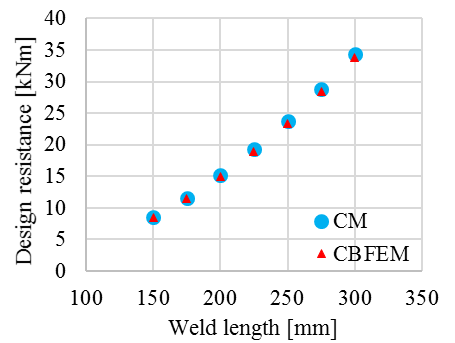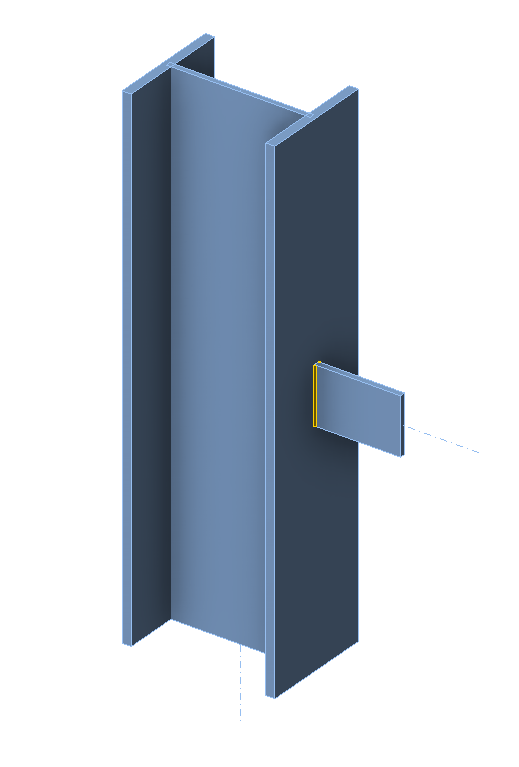Description
In this chapter, component-based finite element method (CBFEM) of a fillet weld in a fin plate joint is verified with component method (CM). A fin plate is welded to open section column HEB. The height of the fin plate is changed from 150 to 300 mm. The plate/weld is loaded by normal and shear force and bending moment.
Analytical model
The fillet weld is the only component examined in the study. The welds are designed to be the weakest component in the joint according to Chapter 4 in EN 1993-1-8:2005. The design resistance of the fillet weld is described in section 4.1. Overview of considered examples and material is given in Tab. 4.3.1. Three load cases are considered: normal force N, shear force V, and bending moment M. Geometry of the joint with dimensions is shown in Fig. 4.3.1.
Tab. 4.3.1 Examples overview
| Example | Material | Weld | Fin plate | Column | ||||||
| fy | fu | E | γM0 | γM2 | aw | hp | tp | e | Section | |
| [MPa] | [MPa] | [GPa] | [-] | [-] | [mm] | [mm] | [mm] | [mm] | ||
| N150 | 235 | 360 | 210 | 1 | 1,25 | 3 | 150 | 10 | 200 | HEB400 |
| N175 | 235 | 360 | 210 | 1 | 1,25 | 3 | 175 | 10 | 200 | HEB400 |
| N200 | 235 | 360 | 210 | 1 | 1,25 | 3 | 200 | 10 | 200 | HEB400 |
| N225 | 235 | 360 | 210 | 1 | 1,25 | 3 | 225 | 10 | 200 | HEB400 |
| N250 | 235 | 360 | 210 | 1 | 1,25 | 3 | 250 | 10 | 200 | HEB400 |
| N275 | 235 | 360 | 210 | 1 | 1,25 | 3 | 275 | 10 | 200 | HEB400 |
| N300 | 235 | 360 | 210 | 1 | 1,25 | 3 | 300 | 10 | 200 | HEB400 |
| V150 | 235 | 360 | 210 | 1 | 1,25 | 3 | 150 | 15 | 100 | HEB200 |
| V175 | 235 | 360 | 210 | 1 | 1,25 | 3 | 175 | 15 | 100 | HEB200 |
| V200 | 235 | 360 | 210 | 1 | 1,25 | 3 | 200 | 15 | 100 | HEB200 |
| V225 | 235 | 360 | 210 | 1 | 1,25 | 3 | 225 | 15 | 100 | HEB200 |
| V250 | 235 | 360 | 210 | 1 | 1,25 | 3 | 250 | 15 | 100 | HEB200 |
| V275 | 235 | 360 | 210 | 1 | 1,25 | 3 | 275 | 15 | 100 | HEB200 |
| V300 | 235 | 360 | 210 | 1 | 1,25 | 3 | 300 | 15 | 100 | HEB200 |
| M150 | 235 | 360 | 210 | 1 | 1,25 | 3 | 150 | 15 | 200 | HEB400 |
| M175 | 235 | 360 | 210 | 1 | 1,25 | 3 | 175 | 15 | 200 | HEB400 |
| M200 | 235 | 360 | 210 | 1 | 1,25 | 3 | 200 | 15 | 200 | HEB400 |
| M225 | 235 | 360 | 210 | 1 | 1,25 | 3 | 225 | 15 | 200 | HEB400 |
| M250 | 235 | 360 | 210 | 1 | 1,25 | 3 | 250 | 15 | 200 | HEB400 |
| M275 | 235 | 360 | 210 | 1 | 1,25 | 3 | 275 | 15 | 200 | HEB400 |
| M300 | 235 | 360 | 210 | 1 | 1,25 | 3 | 300 | 15 | 200 | HEB400 |
Fig. 4.3.1 Joint geometry with dimensions
Numerical model
The model of the weld in CBFEM is described in section 3.4. The weld model has an elastic-plastic material diagram, and stress peaks are redistributed along the weld length.
Verification of resistance
Design resistance calculated by CBFEM is compared with the results of CM. The comparison is presented in Tab. 4.3.2. The study is performed for one parameter: length of the weld, i.e. height of the fin plate, and three load cases: normal and shear force and bending moment. The shear force is applied in a weld plane to neglect the effect of an additional bending. The bending moment is applied at the end of the fin plate. The influence of the weld length on the design resistance of the fin plate joints loaded by the normal and shear force are shown in Fig. 4.3.2. The relation between the weld length and the bending moment resistance of the joint is shown in Fig. 4.3.3.
Tab. 4.3.2 Comparison of CBFEM and CM
| Example | Design resistance | Example | Design resistance | Example | Design resistance | ||||||
| CM | CBFEM | diff. | CM | CBFEM | diff. | CM | CBFEM | diff. | |||
| [kN] | [kN] | [%] | [kN] | [kN] | [%] | [kNm] | [kNm] | [%] | |||
| N150 | 229 | 226 | -1 | V150 | 187 | 186 | -1 | M150 | 8,6 | 8,5 | -1 |
| N175 | 267 | 264 | -1 | V175 | 218 | 216 | -1 | M175 | 11,6 | 11,5 | -1 |
| N200 | 305 | 301 | -1 | V200 | 249 | 247 | -1 | M200 | 15,2 | 15,0 | -1 |
| N225 | 343 | 338 | -1 | V225 | 280 | 278 | -1 | M225 | 19,3 | 19,0 | -2 |
| N250 | 381 | 375 | -2 | V250 | 310 | 309 | 0 | M250 | 23,8 | 23,4 | -2 |
| N275 | 419 | 412 | -2 | V275 | 342 | 341 | 0 | M275 | 28,8 | 28,4 | -1 |
| N300 | 457 | 449 | -2 | V300 | 374 | 372 | -1 | M300 | 34,3 | 33,8 | -2 |
The results of CBFEM and CM are compared, and the sensitivity study is presented. The influence of weld length on the design resistance in a fin plate joint loaded by normal force is shown in Fig. 4.3.2, by shear force in Fig. 4.3.3, and by bending moment in Fig. 4.3.4. The study shows good agreement for all applied load cases.
Fig. 4.3.2 Parametric study of fin plate joint loaded by normal force
Fig. 4.3.3 Parametric study of fin plate joint loaded by shear force
Fig. 4.3.4 Parametric study of fin plate joint loaded by bending moment
To illustrate the accuracy of the CBFEM model, the results of the parametric studies are summarized in a diagram comparing the design resistances of CBFEM and CM; see Fig. 4.3.5. The results show that the difference between the two calculation methods is in all cases less than 10 %.
Fig. 4.3.5 Verification of CBFEM to CM
Benchmark example
Handcalc
Inputs
Column
- Steel S235
- HEB 400
Fin plate
- Thickness tp = 15 mm
- Height hp = 150 mm
Weld, double fillet weld see Fig. 4.3.6
- Throat thickness aw = 3 mm
Outputs
- Design resistance in pure bending MRd = 8.5 kNm
- Design resistance in pure shear VRd = 186 kN
- Design resistance in pure tension NRd = 226 kN
Fig. 4.3.6 Benchmark example for the welded fin plate joint







